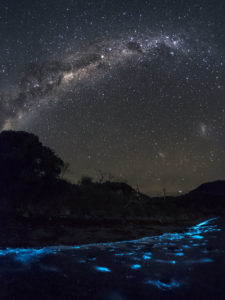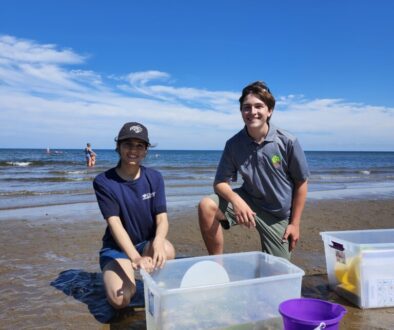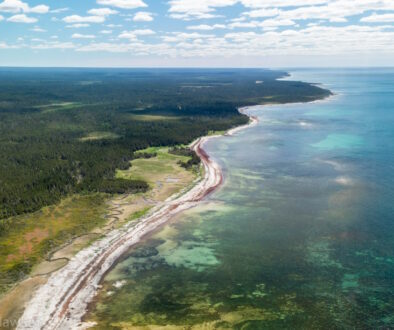Walking with sparkling phytoplankton
It was a dark night. The sky was cloudy, obscuring the moon that we could usually depend on to light up the beach in front of us. Our eyes, still used to light from the campfire we had just put out, struggled to make sense of the familiar path. We stumbled some over the rocks in the sand. I offered my grandmother my arm as we continued up the beach, thinking of nothing except reaching the camp at the end of the sand and crawling into my warm bed. I barely glanced at the dark saltwater that stretched for miles without interruption to my right, though I could hear the waves lapping against the shoreline. It was my grandmother who called out softly for my younger sister and I to stop.
“It’s very dark,” she said slowly, “and just the right time of year. Maybe, just maybe, the water will glow tonight.” In a moment, my exhaustion disappeared, and I excitedly turned to meet my sister’s eyes. Neither of us had ever seen the water sparkle as it does only a few nights a year, though we had been coming to the camp on the small island just off the coast of St. George, New Brunswick since we were months old. We had heard many stories from older members of my family, and it was a dream of ours to experience it for ourselves.

Grandma warned us not to get our hopes up, but it was too late. Without hesitation, we changed paths and started moving towards the water, taking care over the slippery seaweed and jagged rocks. With her decades of familiarity with the beach, Grandma kept up, and it wasn’t long before we were standing at the water’s edge. In unison, my sister and I each picked a rock out of the sand and hurled them forward, breaking the surface. Water splashed my toes, but that wasn’t why I gasped. For an instant, it was as though we were looking at a different world. The water erupted into brilliant sparkles, revealing the outlines of shapes beneath the waves.
Sleep pushed far into the back of our minds, my sister and I spent an hour on the dark beach, throwing more rocks and eventually rolling our pants up and wading into the Atlantic Ocean. The water lit up as we moved and followed our legs in a dazzling stream that petered out behind us as we walked deeper into the gentle waves. Having seen the phenomenon many times before, Grandma eventually grew tired of admiring the starry water and continued up to the camp. My sister and I lingered on the beach after our legs had grown numb from the cold saltwater, watching the water flicker as it rocked against the shore while we chatted about what we had seen. We shared the opinion that phytoplankton are some of the coolest sea creatures on the planet!
Plankton are any type of free-standing organism that drift through the ocean currents, serving as a valuable food source for many animals. Plankton is broken into two categories: zooplankton, tiny floating animals, and phytoplankton, tiny floating plants. Many species of plankton can light up the water with their ‘bioluminescence’, but one group of phytoplankton, called dinoflagellates, are particularly well known for their bright night-time presence. Dinoflagellates glow when the water that surrounds them is disturbed as a defence mechanism. The flash of light they release is meant to scare away predators that might want to eat them, or to attract larger predators that might eat their attackers.

A small miracle by tiny organisms, phytoplankton like dinoflagellates can only spark at certain times of the year. Water, weather, and nutrient conditions must be just right, and the phytoplankton have to gather in groups of millions or billions! It takes over 100,000 tiny dinoflagellates per every one litre of water to create the starry effect I saw on that dark August night. The night must be a deep dark to see the beauty of the phytoplankton’s faint flash, and the days must be hot and long with lots of sunlight. Much like a solar lamp charging through the day and lighting up at night, these tiny drifting plants need energy from the sun to glow. This means they are most often seen in the late summer months, and only in the shallow shoreline where the sun can easily reach them during the day.
To experience the shocking beauty of bioluminescent phytoplankton for yourself, head to the beach on a dark night during the summer months and cross your fingers. It may take years but witnessing the glittering beauty of this natural miracle first-hand is more than worth the wait!
Header photo by “_DSC0511.jpg” by rlangone is licensed under CC BY-NC-SA 2.0

Maddie Carr is a third-year student at the University of New Brunswick pursuing a major in Interdisciplinary Leadership Studies and a minor in Environmental Studies. She is currently a Conservation Outreach Assistant with CPAWS NB. The opportunities she has received here to expand her knowledge on the importance of protecting and appreciating natural areas is preparing her for her future goals of supporting conservation work in the environmental non-profit sector. Maddie firmly believes that those who experience nature want to protect it, which is why she spends a lot of time exploring wild areas like New Brunswick’s parks and encourages others to do the same!



